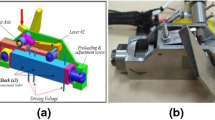Abstract
In order to model the hysteresis behavior of a nano piezoelectric actuator (PA) on nano scale in a real time system, a new hysteresis modeling method based on an improved sub-pixel blocking matching algorithm with an optimal block size is proposed in this paper. First, Preisach model is introduced to model the hysteresis behavior of a piezoelectric actuator. Then, a real time block matching algorithm is researched and its block size is optimized with a standard object. Finally, experiments are performed with respect to a nanometer movement platform system, and the results show the feasibility and validity of the sub-pixel estimation based block matching algorithm and its application in modeling the hysteresis behavior of PA.
Similar content being viewed by others
Eeferences
Rangasamy M. Nano technology: A review. J Appl Phar Sci, 2011, 1(2): 8–16
Croft D, Shed G, Devasia S. Creep, hysteresis, and vibration compensation for piezoactuators: atomic force microscopy application. J Dyn Syst, Meas Contl, 2001, 123(1): 35–43
Putra A S, Huang S N, Tan K K, et al. Design, modeling and control of piezoelectric actuators for intracytoplasmic sperm injection. IEEE T Contl Syst Technol, 2007, 15(5): 879–890
Lee F S, Chiang S F, Jhang J J, et al. Prototyping of a hybrid driver for nano-manipulation using piezoelectric actuators. Proceedings of the 4th International Conference on Mechatronics, Kuala Lumur, May 17–19, 2007. 1–5
Basso V, Sasso C P, LoBue M. Thermodynamic aspects of first-order phase transformations with hysteresis in magnetic materials. J Magn Magn Mater, 2007, 316(2): 262–268
Peng J Y, Chen X B. Modeling of piezoelectric-driven stick-slip actuators, IEEE/ASME T Mech, 2011, 16(2): 394–399
Tan U X, Win T L, Tang W. Modeling piezoelectric actuator hysteresis with singularity free Prandtl-Ishlinskii model. Proceedings of the 2006 IEEE International Conference of Robotics and Biomimetics, Kunming, China, December 17–20, 2006. 251–256
Bashash S, Jalili N. Robust multiple frequency trajectory tracking control of piezoelectrically driven micro/nanopositioning systems. IEEE T Contl Syst Technol, 2007, 15(5): 867–878
Zhou J, Wen C Y, Zhang C J. Adaptive backstepping control of a Piezopositioning mechanism with hysteresis. Trans Can Soc Mech Eng, 2007, 31(1): 97–110
Zakerzadeh M R, Firouzi M, Sayyaadi H, et al. Hysteresis nonlinearity identification using new preisach model-based artificial neural network approach. J Appl Math, 2011, Article ID 458768
Pasco Y, Berry A. Consideration of piezoceramic actuator nonlinearity in the active isolation of deterministic vibration. J Sound Vib, 2006, 289: 481–508
Mayergoyz I D, Friedman G. Generalized Prisach model of hystereisis. IEEE T Mag, 1988, 24(1): 212–217
Szczech J B, Megaridis C M, Gamota D R, et al. Fine-line conductor manufacturing using drop-on demand PZT printing technology. IEEE T Elec Pack Manuf, 2002, 25(1): 26–33
Wei Y J, Wu C D, Dong Z L, et al. Global shape reconstruction of the bended AFM cantilever. IEEE T Nanotechnol, 2012, 11(4): 713–719
Nakayama K. Biological image motion processing: A review. Vision Res, 1985, 25(5): 625–660
Wei Y J, Wu C D, Dong Z L. Global shape reconstruction of nano grid with single fixed camera. Sci China Tech Sci, 2011, 54(1): 1–9
Wei Y J, Wu C D, Dong Z L. An automatic compensation method on compression effect and surface elasticity measurement based on the deflection signal of AFM. Sci China Tech Sci, 2011, 54(9): 2397–2403
Lucas B, Kanade T. An iterative image registration technique with an application to stereo vision. In: Proceedings of DARPA Imaging Understanding Workshop, Vancouver, British Columbia, 1981. 121–130
Singh R. An estimation-theoretic framework for image flow computation. In: Proceedings of the Third International Conference on Computer Vision, Osaka, December 4–7, 1990. 168–177
Barron J L, Fleet D J, Beauchemin S S. Performance of optical flow techniques. Int J Computer Vision, 1994, 12(1): 43–77
Kim J H, Menq C H. Visually servoes 3-D alignment of multiple objects with subnanometer precision. IEEE T Nanotechnol, 2007, 7(3): 321–330
Robinson D, Milanfar P. Fundamental performance limits in image registration. IEEE T Image Proc, 2004, 13(9): 1185–1199
Tian Q, Huhns M. Algorithms for subpixel registration. Comput Vis, Graph, Image Proc, 1986, 35: 220–233
Author information
Authors and Affiliations
Corresponding author
Rights and permissions
About this article
Cite this article
Wei, Y., Wu, C. Modeling of nano piezoelectric actuator based on block matching algorithm with optimal block size. Sci. China Technol. Sci. 56, 2649–2657 (2013). https://doi.org/10.1007/s11431-013-5351-x
Received:
Accepted:
Published:
Issue Date:
DOI: https://doi.org/10.1007/s11431-013-5351-x




